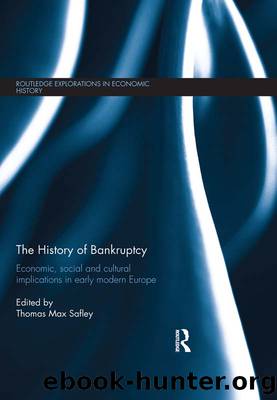The History of Bankruptcy by Safley Thomas Max;

Author:Safley, Thomas Max;
Language: eng
Format: epub
ISBN: 1114675
Publisher: Taylor & Francis Group
8 Bankruptcy and the bank
The case of the âkaiserlich königliche Wiener octroyierte Commercial-, Leih-und Wechselbankâ of Vienna in the 18th century1
Dana Štefanová
Introduction
The way banks treated customers who made mistakes with regard to their businesses or failed because of imperfect market structures (institutional failures, failure of contract enforcement, etc.) represents an under- researched area in business and social history. My chapter concentrates on insolvent or bankrupt businesses and how they were treated by their bank. Recent research points to the fact that 51 new laws of the period, 1808â1914, were designed to protect the interests of creditors in case of bankruptcy.2 Such clear policy aims cannot be taken for granted, as the following case study from the period of enlightened absolutism in the Habsburg Empire illustrates. I shall try to show that much depended then on the social status of the individuals involved and on the political ambitions of state authorities.3
This chapter takes as its example the âkaiserlich königliche [hereinafter kk] Wiener octroyierte Commercial-, Leih- und Wechselbank,â chartered in 1787 by Emperor Joseph II and granted privileges for a period of 25 years. In reality, it remained in business until approximately 1830. The reigns of Joseph II (1780â1790) and his mother, Maria Theresia (1740â1780), were characterized by many enlightened absolutist reforms in religion, politics, society and economy. Economic reforms combined mercantiliswt and physiocratic principles. In the context of this study, the efforts to limit the powers of rural landlords vis-à -vis their villagers seem particularly relevant, designed as they were to register and tax assets in landlord property. These only came into practice, however, with the next cadastral survey in the first half of the nineteenth century.
In order to grasp the bank's reactions and activities with respect to insolvent customers, it is crucial to understand the bank itself. The social background of the entrepreneurs as well as of the customers thus plays an important role in this period of reform as does the management organization of the institution. There follows a brief discussion of the bank. Then, two case studiesâthe Viennese-Greek merchant Johann Georg Paziazi and the woolen manufacturer Johannes Tost of Southern Bohemiaâwill illustrate questions surrounding the issue of bankruptcy.
Download
This site does not store any files on its server. We only index and link to content provided by other sites. Please contact the content providers to delete copyright contents if any and email us, we'll remove relevant links or contents immediately.
Women and Jewish Marriage Negotiations in Early Modern Italy by Howard Tzvi Adelman(377)
Warrior King by Wilbur Smith(307)
18 real-life stories of serial killers and murderers with solved and unsolved killings from the USA, UK, Europe, and beyond. by Ben Oakley(261)
Who's Who in the Zulu War, 1879: The British by Adrian Greaves Ian Knight(252)
Violence and Emotions in Early Modern Europe by Susan Broomhall;Sarah Finn;(236)
The Battle of Austerlitz by 50minutes(223)
The American Crisis by Unknown(219)
The Seeker by S. G. MacLean(202)
The Dutch East India Company and British East India Company: The History and Legacy of the Worldâs Most Famous Colonial Trade Companies by Charles River Editors(198)
The Origins of French Absolutism, 1598-1661 by Alan James(193)
The Traitor of Colditz by Robert Verkaik(182)
A Genius for Confusion by Richard M. Fried(179)
Invisible Worlds by Peter Marshall(179)
The Slave Trade in Africa by Simon Webb;(176)
Fires of Faith by Catholic England under Mary Tudor(175)
Interest and Connection in the Eighteenth Century by Jacob Sider Jost(174)
The Opium Wars: Exploring the Addiction of Empires from Beginning to End by Ramos Adrian & Compacted History(173)
Islam and the Trajectory of Globalization by Louay M. Safi(170)
The Thirty Years War â Complete by Friedrich Schiller(170)
